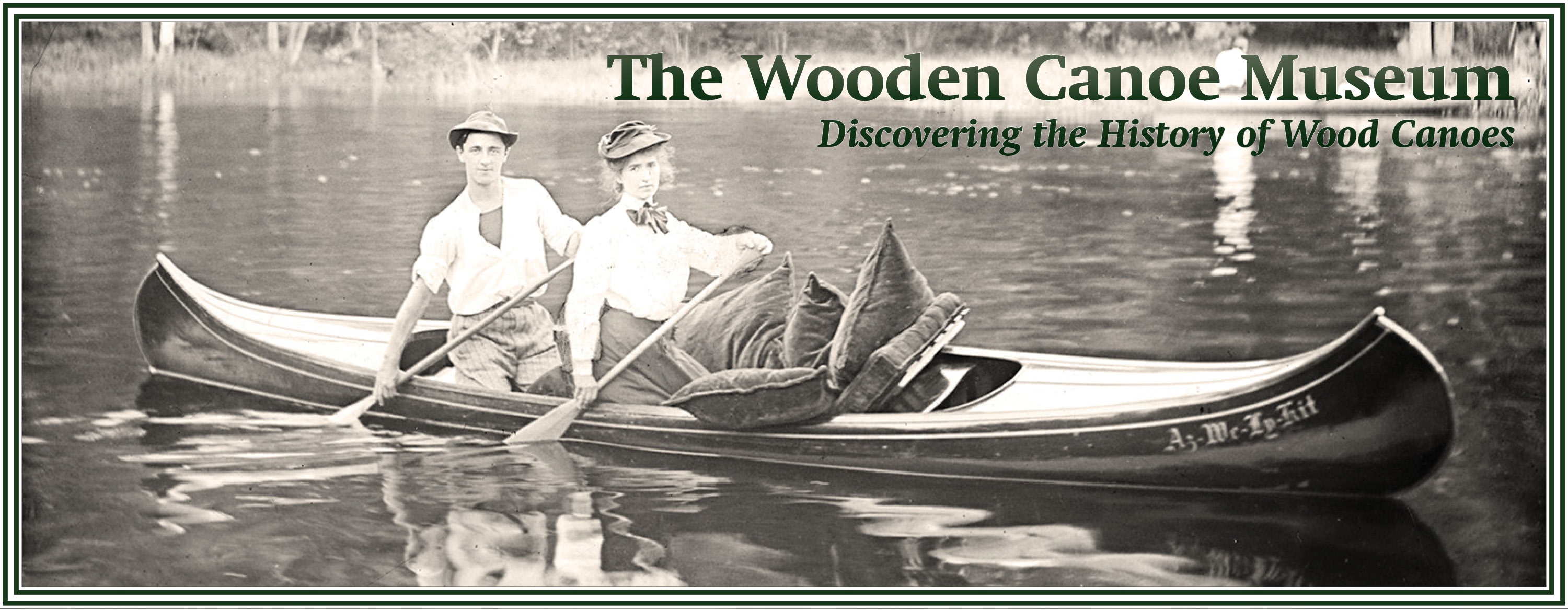Compiled by Howard Herman-Haase. Contact: mailto:hcubed1@mac.com
Note: dates assigned to undated catalogs are in bold italic.
| Cover | Date | Printer/Page Count | Assigning Dates/General Comments | Additional Comments | Catalog Sources |
|---|---|---|---|---|---|
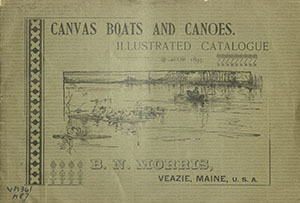 |
1893 | J.H. Bacon, Bangor; 28 pages |
This is the earliest surviving Morris catalog, but a Descriptive Circular, Pricelist, and Catalog are mentioned in 1892 ads. Prior to 1893, Morris focused his efforts on perfecting a canvas version of birch bark canoes, but only one example appears in this catalog. His first agent, L. W. Ferdinand & Co. (LWF), may have influenced the choice to focus on canvas boats in this catalog. Many of the canvas boats in the catalog are based on Bowdish & Co. wooden boat designs that LWF also sold. LWF also appears on this catalog’s title page. LWF had been selling Morris’s birch-bark-inspired Canvas Covered Canoes Indian since 1891. |
The canvasing methods described clearly state that the canvas was cemented and ironed onto the planking. Unlike other models the Indian Model was built in a single grade and had narrow seats mortised into the inwale, cedar ribs. Decks were optional from 18-24 inches. It was a larger canoe more akin to later Lake Canoe and Model B. |
Private Collection (RT) WCHA-Digital Copy |
 |
ca. 1895 |
J. H. Bacon, Bangor;
|
In 1895, Morris reissued the 1893 catalog with 13 new pages inserted, many of which were letters from satisfied customers. Insert describing the Special Indian Model states "The above model was a new design last season, 1894" dating the catalog to 1895, and the first Special Indian to 1894. |
The Special Indian shown has the heart-shaped decks and full-framed caned seats. An optional single thwart was available. The only surviving example is a 17-foot canoe with has ash rails and decks and pine planking and a single ash thwart. Bang plate was attached to cedar stem with rivets. An insert of an Indian Model No. 81, a short very flat and wide canoe was also included. Both canoes were available in three grades. Morris also began building a slightly different Special Indian for LWF by 1895. |
The Mariner's Museum |
| 1896-1899 |
No surviving Morris canvas canoe catalogs from this period. There is evidence that Morris reissued the original 1893 catalog again sometime between 1896 and January 1898 with a new inserted section on Indian Model Canoes. Evidence suggests this edition was still circulating in January 1898. |
Retailer catalogs indicate the Special Indian Model obtained its distinctive wide flat bottom and was only offered in two grades by 1896. | |||
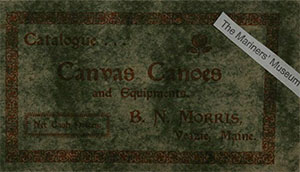 |
1900 | B. N. Morris, Veazie; 16 pages |
This smaller catalog may have evolved from the inserted section on Indian Model Canoes mentioned above. It includes only three models, the Special Indian Model, the Indian Model Extra Beam and the Indian Model for Speed, the predecessors of the Model A, Model B, and Model C, which would be introduced in 1907. In the Introduction Morris makes the reasonable claim that birch-bark inspired canvas covered canoes had been around for at least twenty-five years (1875), were initially very rough but had been perfected, in Maine on the Penobscot River. Iver Johnson Sporting Goods changed this claim in their contemporary catalogs to read Morris had been building canvas canoes for twenty-five years; a claim he never made. |
Traditional canvasing techniques described in the catalog (no cementing and ironing). Two grades available: First Grade had cedar ribs and planking, spruce rails, mahogany decks, seat frames and braces; seats caned or upholstered, and brass bang plates. Mahogany and Oak rails are available. Keel is special order. Thumb nuts can be requested on center brace. |
The Mariner's Museum |
 |
1901-1902 |
B. N. Morris, Veazie; |
No major changes to the 1900 Catalog. Morris repeated the claim about the history of canvas canoes. He continued to make and repeat these types of statements to establish dates in the past in other catalogs. I only include the date associated with the earliest occurrence of the statement. |
Indian Model Extra Beam is only available in first grade. Includes a detailed description of slat flooring. |
Private Collection (JWD)
|
 |
1903 |
B. N. Morris, Veazie; |
This catalog is similar to the previous two catalogs in most respects, but there were important changes. Second grade canoes eliminated. All Morris Canoes were now High Grade. The Indian Model Lake Canoe replaces the earlier Indian Model Extra Beam. A less expensive Special Indian Model for Hunting was introduced. The Introduction was removed. |
Standard High Grade Morris Canoes had cedar planking, spruce rails, mahogany decks (15-inch), braces and seat frames, and caned seats. The 17 and 18-foot Special Indian Model are ½-inch and 1½-inches deeper. The Special Indian for Hunting had oak decks, braces and seat frames and was less finished. 24-inch mahogany decks were added as option. Oak rails and upholstered seats were no longer listed as options. Thumb nut now standard on center brace. Center brace on 17 and 18-foot models was removable. |
Private Collections (DJM, JWD) WCHA-Digital Copy |
| 1904-1906 | No surviving Morris canvas canoe catalogs from this period. A surviving Iver Johnson Sporting Goods catalog most likely dating 1906, shows Special Indian Model with dimensions identical to earlier 1901-1902 Morris catalog. | The August 12, 1906, edition of the Paterson Sunday Chronical describes an 18-foot Courier racing canoe with open wales that Morris provided as a raffle prize as part of the second annual Water Carnival. | |||
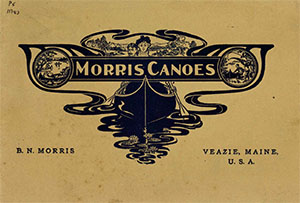 |
ca. 1907 |
Fort Hill Press Samuel Usher, Boston; |
This is the earliest in a series of undated Morris Canoes catalogs with the same graphic design presented in different color combinations. It is the first catalog with the Model A, B, and C. This catalog can be no later than 1907 because the July 1907 issue of Fore n’ Aft describes the Models A, B, and C using language taken from the catalog. It cannot be any earlier because the catalog states the predecessor of the Model C was the Courier, which was still sold in 1906 (See additional comments for 1904-1906 above). This was the first Morris catalog that did not offer a less expensive alternative to the standard Model. In the Introduction Morris claims that the first Morris factory was completed in 1887 and that it was that same year that the method of stretching the canvas over a solid planked hull was adapted. Previously, he had been building in the manner of the birch bark canoes with loose ribs and planking with a tight skin of canvas. |
Model A was a slightly changed version of previous Special Indian Model. Type 1: spruce gunwales, mahogany decks, seat frames, and braces, spruce grate, keel, polished bang plates. Open wale, heavy outwale, 5-inch mahogany braces, sailing and rowing equipment available. Ash rails available on request. Standard brace locations specified. Keels, ½-inch on shoe, ¾-inch deep, and 7/8-inch at the base are standard. Tapered to width of bang plate, which runs 30-inches along keel. Attached at every rib (Some surviving Indian Models are attached at every other rib). Canoe without keel is a special order. |
Maine Maritime Museum The Mariner's Museum |
| 1908-1909 | No surviving Morris Canoes catalog from this period. | ||||
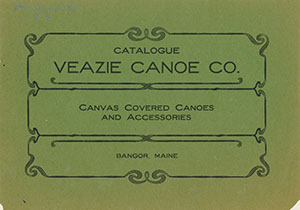 |
ca. 1908 | Burr Printing Co., Bangor; 12 pages |
This catalog is dated 1908 for the following reasons. Morris ran a couple of large advertisement for the Veazie Canoe Company in the Boston Transcript in the spring of 1908, which included an illustration and language taken directly taken from this catalog. Records of the Providence Public Library note the receipt of two pamphlets from the Veazie Canoe Company in 1908. The Veazie Canoe Company appears for the first time in the Maine Board of Assessors Incorporation in 1908. Morris had eliminated a more affordable canoe from his 1907 catalog and the Veazie Canoe was most likely introduced to fill that gap. In the Introduction Morris claims that the transition to a solidly planked shell occurred “about twenty years” ago (1888), which supports the 1887 claim of the 1907 Morris Canoes catalog. Morris claims factory direct sales allowed him to offer a more affordable canoe. Retailer ads for Veazie canoes do not start showing up until 1911, suggesting he did only do direct sales for a few years. See the 1911 Veazie catalog below. |
Contains a very detailed description of standard canvasing techniques. The standard Veazie Canoe had pocketed cedar ribs tapered from 2¼-inches to 1¼-inch and 1¾-inches apart; cedar planking 3/16-inch thick; spruce wales; 15-inch keyhole decks, two seat frames, and two thwarts of maple or ash; polished brass bang plates, and spruce removable flooring. Models with or without keel kept in stock. Mahogany long decks (24-inch),seat frames, braces and rails were an option, as were oak outside stems. Sailing equipment was also available. The Veazie Canoe was wider than the Model A at the rails with less tumblehome and was 2-inches lower at the ends. The 16-foot Morris Type 1 Model A was $40 with keel and spruce grate in bottom compared to the standard Veazie Canoe was $31 without keel and slat floor. All photos of Veazie Canoes show the keyhole deck design. |
Maine Historical Society University of Virginia WCHA-Digital Copy |
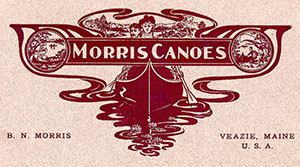 |
ca. 1910 |
Kennebec Journal Press;Burleigh & Flynt, August; 32 pages, 1 insert |
This catalog is no earlier because the Morris Motor Boat described is most likely the one referenced in the list of New Boats in June 1910 issue of Motor Boat Magazine. This is the only surviving Morris catalog that includes Motor Canoes and there only other appearance is in a series of 1910 ads for Dintaman’s Livery and Sales Pavilion which stated that Morris canoes “Can be equipped with a high-class motor or sponson if desired.” Very similar in design and content to 1907 Catalog, but the Morris factory is described as having 65,000 square feet, while the 1907 Morris and 1908 Veazie catalogs specify 50,000 square feet. The Introduction does not contain any claims regarding dates or early canvas canoe building methods. |
A 20-foot Model A and a 13-foot Model B were added to this catalog. Some regular 18-foot Model A and B canoes with small motor installed were kept in stock as Motor Canoes. Inserted page describes earliest Morris Motor Boat, the 20ft x 3-foot Model A . Earliest mention of sponsons, with canvas covered or mahogany decks as an option. |
Private Collection (BG) WCHA-Digital Copy |
 |
1911 |
B. N. Morris, Veazie; |
This is a mini catalog with excerpts from the full 1911 catalog. The first three pages provide a more detailed description of the Canvas Motor Boat introduced in the 1910 Catalog. The prices in this catalog are significantly higher and more in step with later advertisements, indicating that it is later. The remaining pages include select content from the full Morris Canvas Canoes catalog. |
Advertisements for Canvas Motor Boats begins in 1911 and continues to the end of 1915. |
Private Collection (JWD) WCHA-Digital Copy |
| 1911 |
There is no surviving copy of the full 1911 Morris Canoes catalog. We know it was published because the mini catalog concluded with COMPLETE CATALOGUE FREE UPON REQUEST. |
We do not know if this catalog included the information on Canvas Motor Boats in the mini catalog, but none of the later Morris Canvas Canoes catalogs included information about these boats even though Morris Canvas Motor Hulls advertisements continued. Morris did publish catalog dedicated to Motor Boats circa 1913. |
|||
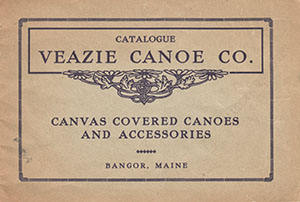 |
ca. 1911 | Walker Lith. & Pub. Co, Boston; 12 pages |
Although much of the content of this later Veazie Canoe Catalog is the same as the earlier one, it states that the Veazie Canoe Company now had "Agents in Principal Cities" and no longer includes the discussion of factory direct sales. This catalog is dated circa 1911, the year retailer ads for Veazie Canoes began appearing. This catalog is also the earliest containing “The Kenyon Life Preserving Pillow,” which entered the market in 1910, and apparently Morris started including in his catalogs in 1911. Introduction from first catalog was removed. |
Open spruce wales were added as an option on Veazie Canoes. Two prices now provided “With Keel” and “With Keel and Open Spruce Wales:”
|
Private Collection (DJM) |
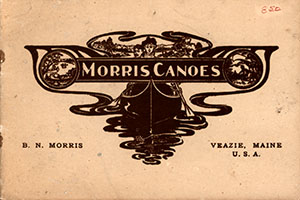 |
ca. 1912-1913 |
Griffith-Stillings Press, Boston; 32 pages (Pages 15-18 missing from known copy) |
Includes new page header design with two lines and text in between. The price of cleats and lines for sailing rigging in the two Griffith-Stillings Press catalogs are slightly more than those is the 1910 catalog, but slightly less than those in the 1914 catalog, and are therefore placed between them. There is no way to determine which catalog is 1912 and which is 1913. All Previous catalogs including the 1911 mini-catalog and the 1911 Veazie Catalog offered single paddles in three grades. Beginning with these catalogs they were only offered in two grades, indicating they are no earlier than 1912. It also indicated that the Morris’s 1911 Canvas Canoes is missing. The 1912 was the earliest of three catalogs with the claim in the Introduction that Morris canoes have been on the market for twenty-one years (1891). In another section of these catalogs Morris claims he was the first to advertise canvas-covered canoes in 1887 in Field & Stream Magazine. |
Eliminated option for ash rails. Special wide flat keel (2-3-inches wide, ½-inch deep) 30-inch and 36-inch mahogany decks option on Type 3 finish. New canoe photos included full photo of open wale canoe. Several photos inside the factory added. |
Private Collection (BG) WCHA-Digital Copy |
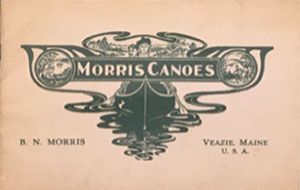 |
ca. 1912-1913 | Griffith-Stillings Press, Boston; 32 pages |
Private Collection (DJM, BG) WCHA-Digital Copy |
||
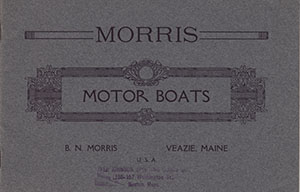 |
ca. 1913 | Burr Printing Co., Bangor; 16 pages |
This catalog has the same header design seen in the 1912/1913 and 1914 Morris Canoes catalogs. Unlike the earlier models, the Model A and Model B Canvas Motor Boats in this catalog include upholstered seats. The 1913 date is assigned because the upholstered seats begin appearing in advertisements in February 1913 using the Model A image in Plate 2 from this catalog, which has the bow facing left unlike the earlier ads. A detailed description of later Model A in the July 1913 issue of Motor Boating also uses this same image. The latest reference to Morris Canvas Motor is a description of the Model B in the December 1915 issue of Motor Boating. In the introduction Morris claims that his canvas covered canoes were first put on the market in 1889. |
Model A: 20-feet long by 38-inches wide, 15 mph with one person Model B: 20-feet long by 4-feet wide, 14 mph with one person Hulls made 5/16-inch cedar planking and flat cedar ribs placed close. Palmer (Q-2) Motor, 2-stroke, Bore 3¾, 3½-inch stroke, 175 pounds. |
Antique Boat Museum |
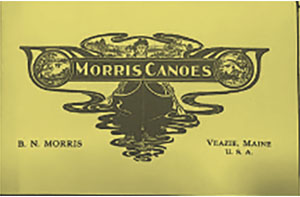 |
ca. 1914 | Walker Lith. & Pub. Co., Boston; 32 pages |
The layout and content of this catalog is identical to the previous two Griffith-Stillings Morris Canoes catalogs except the pricing for the cleats and line are slightly more expensive. The catalog is dated circa 1914 because these prices are the same as found in the circa 1915 and the 1916 catalog. |
University of Virginia Private Collection (BG) WCHA-Digital Copy |
|
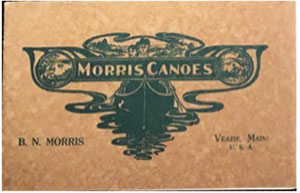 |
ca. 1915 | Coe-Printwell Advertising Services, Portland; 32 pages |
This catalog has a unique single line page header design. The Coe-Printwell Morris Canoes catalog has a completely different layout and new introductory information and photos that are also seen in the 1916 Morris Canoes catalog. This information places it between the Walker Lith. & Pub. Co. catalog and the 1916 catalog. This is the earliest of two catalogs where Morris claims Morris Canoes have been on the market for 26-years (1889). |
Auxiliary ribs added as option. Rub rails added as option. Bilge keels added as option |
Private Collection (BG) WCHA-Digital Copy |
 |
1916 | B. N. Morris, Inc., Veazie; 32 pages |
New Page design with single line under text. Updated Factory illustration< |
Model A Special Ends available. 42-inch and 50-inch decks available. Type 1 with outside stems kept in stock 30, 36, 42, 50-inch mahogany decks available for Type 2 and Type 3. Tuscarora racing canoe Model No. 10., 17-feet long, 31-inch beam introduced. Earliest depiction of canoe with crescent-shaped short decks. |
Private Collection (PM) WCHA-Digital Copy |
 |
1917 | B. N. Morris, Inc., Veazie; 32 pages |
Same page design with mix of new and repeated content, and some reordering. Earliest catalog including the section Morris-The Pioneer that claims, “When Mr. Morris began the manufacture and sale of Canvas Covered Canoes thirty-fine years ago…” (1882). Morris repeats this claim in this catalog stating 'Morris Canoes have thirty-five years of proof behind every statement made in this catalog’ |
One Model A shown with crescent-shaped short decks. Replacement decks are crescent-shaped decks. Model A Special Ends not listed as option and no pricing, illustrations include. Introduction of long deck designs styles.
17 and 18-foot Tuscarora added, spruce rails, decks, seat frames, and braces. No keel or floor rack. 30, 36, 42, 48, 52-inch decks available. Double End Canvas Covered Row Boat added. Model B is offered in several lengths with 48-inch bow decks and 24-inch stern decks.
|
Private Collection (BG) WCHA-Digital Copy |
| 1918 | There are no known Morris Canoes catalog from 1918. | ||||
 |
1919 |
B. N. Morris, Inc., Veazie; |
Same page design and very similar to 1917 except added information on required price changes. |
Special Ends (Torpedo ends) are included as an option in description of Model A. Outdoor Motor Canoe with flat stern added. |
Private Collection (BG, DJM) WCHA-Digital Copy |
